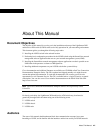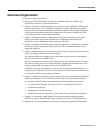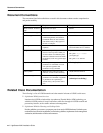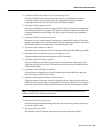
xvi LightStream 2020 Installation Guide
Document Conventions
Document Conventions
The conventions listed inthe table below are usedin this document toenhance reader comprehension
and product usability.
Related Cisco Documentation
The following is a list of LS2020 manuals and other material relevant to LS2020 switch users.
• LightStream 2020 System Overview
Introduces the LS2020 switch and the Asynchronous Transfer Mode (ATM) technology on
which the LS2020 product is based. It describes traffic flow through an LS2020 network and
presents key features, such as traffic and network management.
• LightStream 2020 Site Planning and Cabling Guide
Provides guidelines you can use as you prepare your site to receive LS2020 hardware. It includes space,
environmental, and electrical requirements; rack selection guidelines; requirements for the management
workstation; and information on cables and connectors.
Convention Purpose Example
Bold screen literal
type
Represents user input. $ date
Screen literal type Represents system output. Wed May 6 17:01:03 EDT 1994
Boldface type Denotes names of commands,
command arguments, and switches.
Command names are case sensitive;
enter them exactly as they appear in
the text or examples.
Issue the clear command.
Italic type Used for titles of documents and for
emphasis.
LightStream 2020 Configuration
Guide. File names are case sensitive.
Angle brackets <> Indicate user-specified parameters or
classes of user responses. When you
see this notation in command syntax,
make the substitution enclosed within
the brackets, but do not type the angle
brackets.
If you see:
set port <c.p> <state>
you might type:
set port 4.3 active
Square brackets [ ] Indicate optional arguments or
parameters for commands. You can
omit optional arguments and
parameters in any command.
cli> help [<topic>]
Caret symbol ^ When the caret symbol precedes a
character, it refers to the control key.
^X (the same as Control X)
Curly braces{ } Indicate a choice of argument or
parameters for commands. Arguments
or parameters are separated by a
vertical line{|}, and you must select
one.
cli> set cli traplevel
{off
|info|oper|trace|debug}








